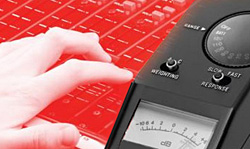
If we are at a team retreat with 50 people, we might need a speaker-on-a-stick for the leader and a keyboard.
If we are in a gym with 800, we might need a PA for the band.
And in an arena, we need even more because the awesome sound of thousands of worshipping voices is loud, and that requires sound reinforcement levels to enable the worship team to be heard.
Some 7,200 voices in our awesome acoustic space instantly buried our 95 dB peak cap. Awesome indeed, but also very challenging.
Pushing the leader on top of the room meant getting uncomfortably loud for unknown seats, so we had to under-support the stage for the greater good.
At least until the system was leveled out so the FOH mix position had a good representation of the louder parts of the room (one of our 19 identified goals of tweaking the system).
The level in the PA for sound reinforcement needs to be proportional to the level of the congregation singing.
Keeping congregational participation as a present element of the overall mix has become a personal priority.
Non-Worship
What about when the congregation is not singing? Then the volume needs to be proportional to the amount of energy being visually expressed from the stage.
If it’s a video roll, then consideration needs to be given to what effectively supports it.
Most of us have been to the previews at movie theaters. If you had an SPL meter in there, you might be surprised at the levels that move you emotionally. Less than that could be considered wimpy or gutless, or emotionally perceived as less bold, confident, or credible.
Proportional means in the louder parts as well as in the quiet ones.
Sometimes the most effective level for an element or a transition is actually silence, which becomes redefined as the noise floor of your facility.
For Willow, that means the sum of the moving light fans and the LED screen fans. We even kill some of these cooling systems at certain times (with careful monitoring) so the bottom of the dynamic range of a service can be more effective.
If thousands can hear a pin drop, the stage might be set for a defining moment in someone’s life. Just like what can happen with a rockin’ song where the power of music can prepare a different person for that same kind of moment.
Proportional to Stage
Volume also needs to be proportional to the stage noise levels to be effective. Our stage is quiet, with all monitors typically being in-ear monitors (IEMs). Our loudest stage-level sources are guitar speakers and an organ’s Leslie mic’d backstage, as well as the drum kit.
Still, for localization to not be thrown out the window, and to avoid arrival timing confusion, I have observed that the PA covering seats closer to the stage needs to be at least 5 dB hotter than the acoustic arrivals from the stage.
This number is more complicated than pure masking, as it includes acoustic reflections off the stage floor, front fills blending with the PA, and a different psychological experience when you are a few feet from the live action.
When you are further back, well into the “meat” of the PA, image magnification (IMAG) screens become part of the overall experience, also impacting how volume “feels.”
